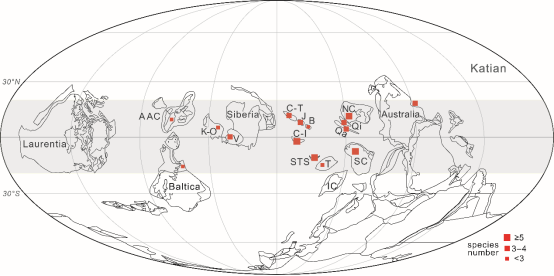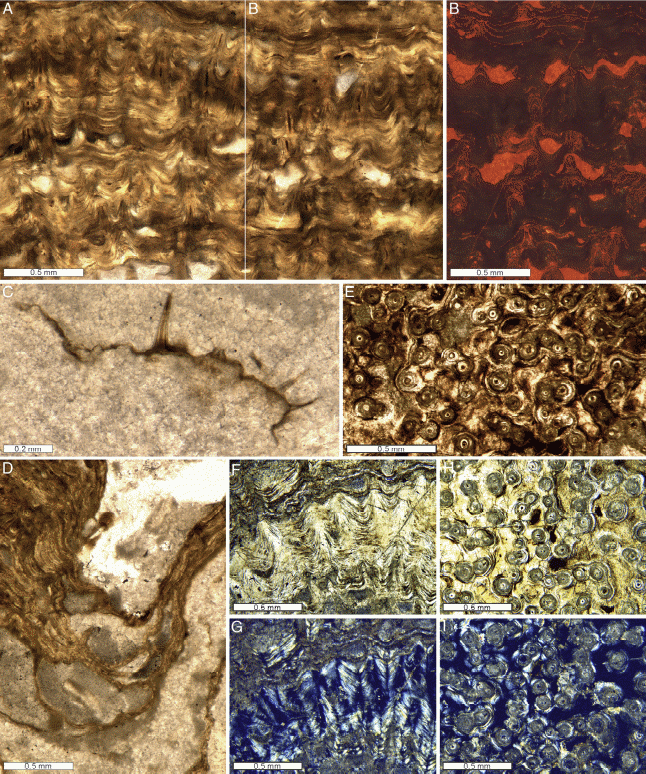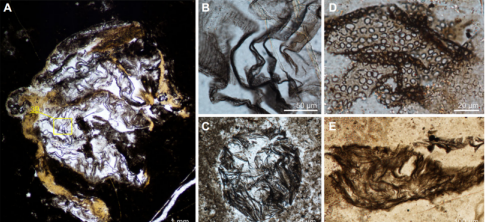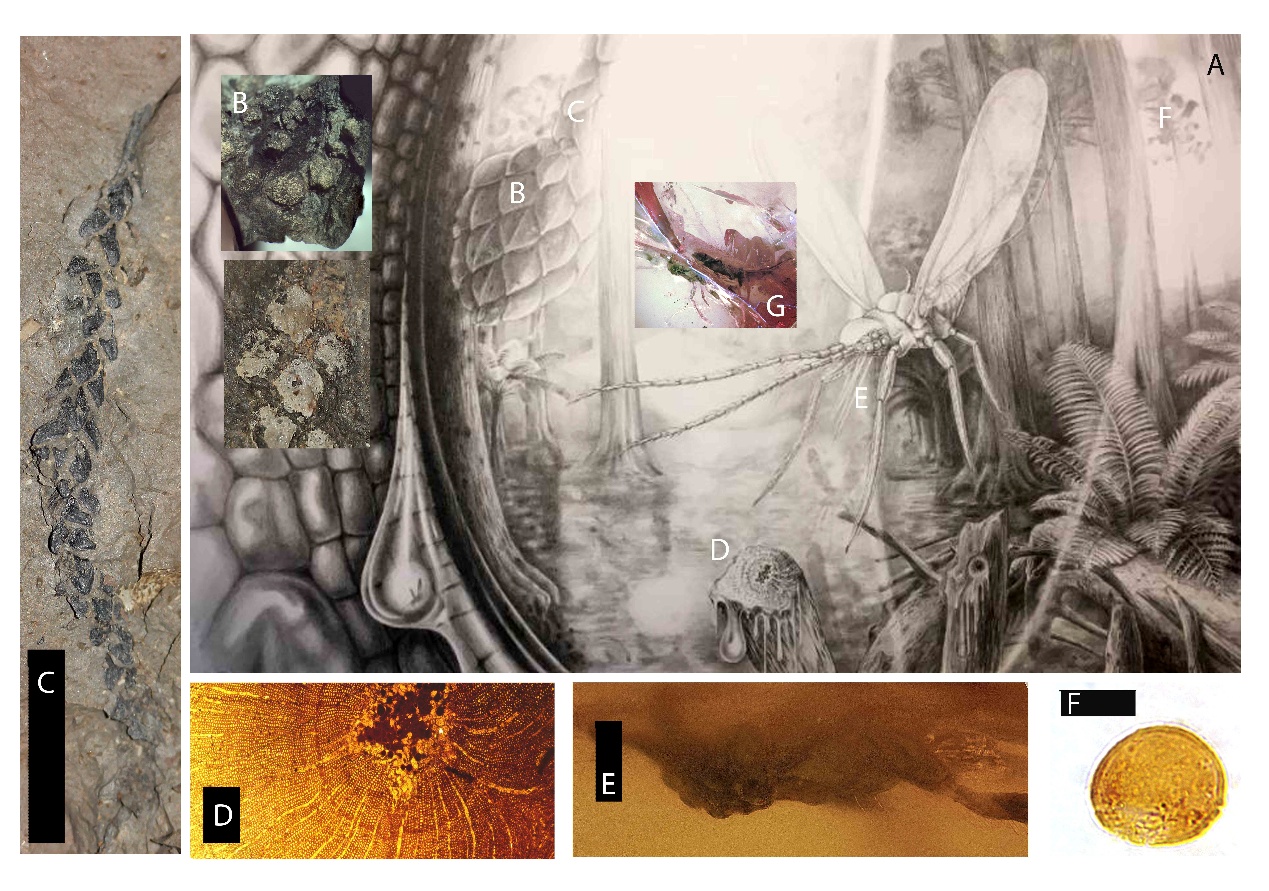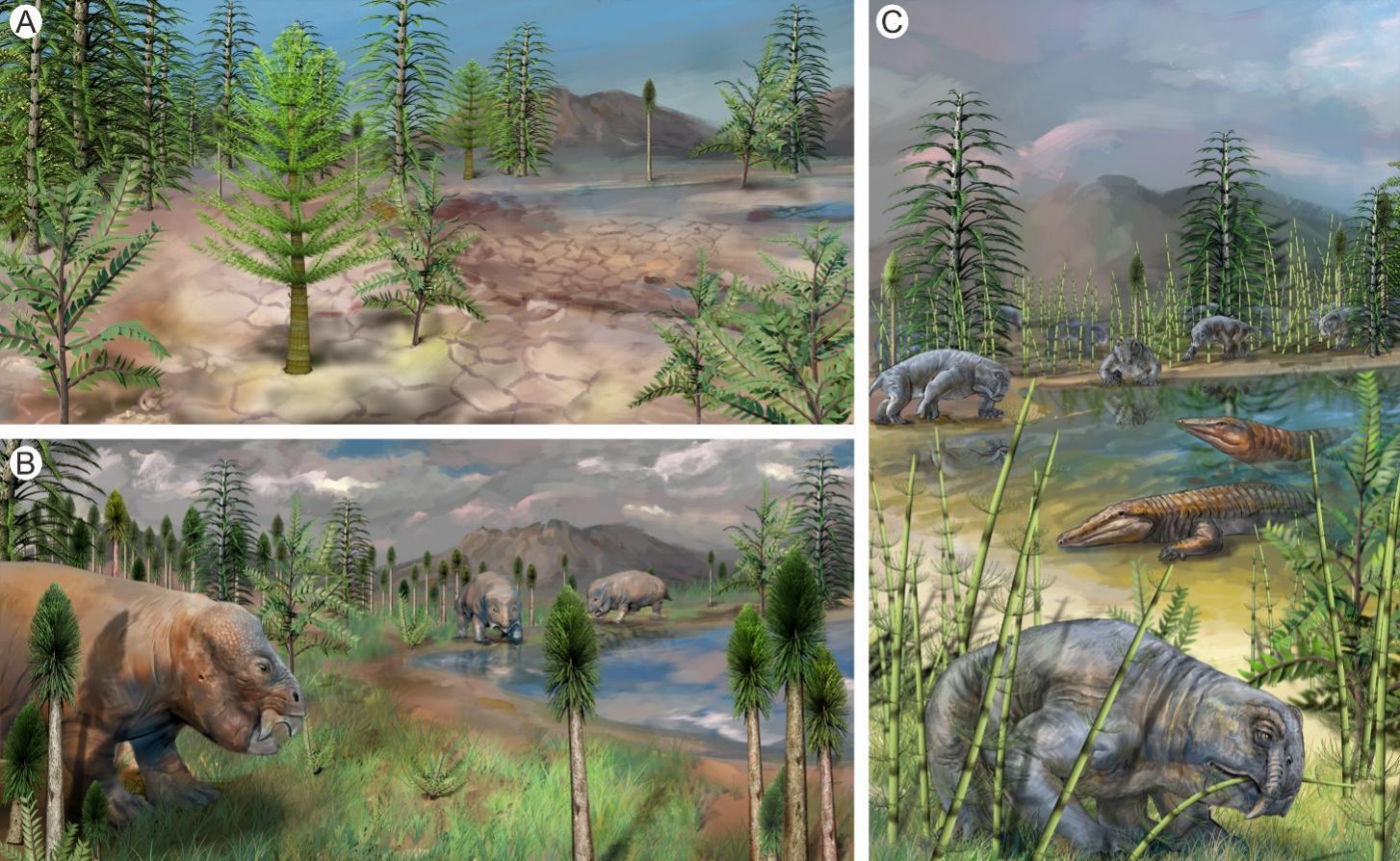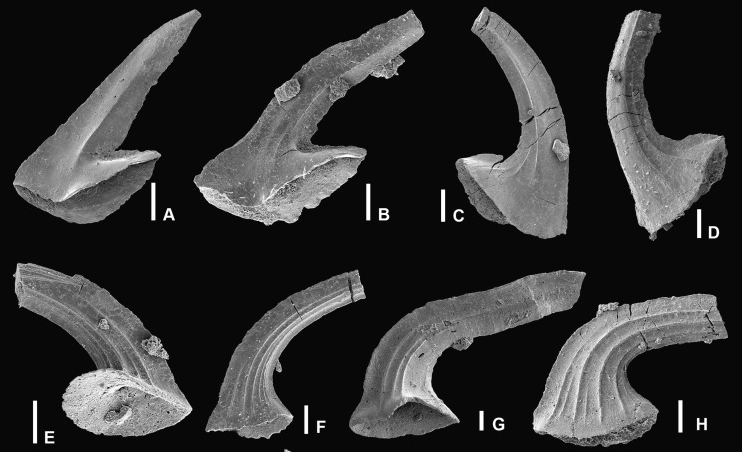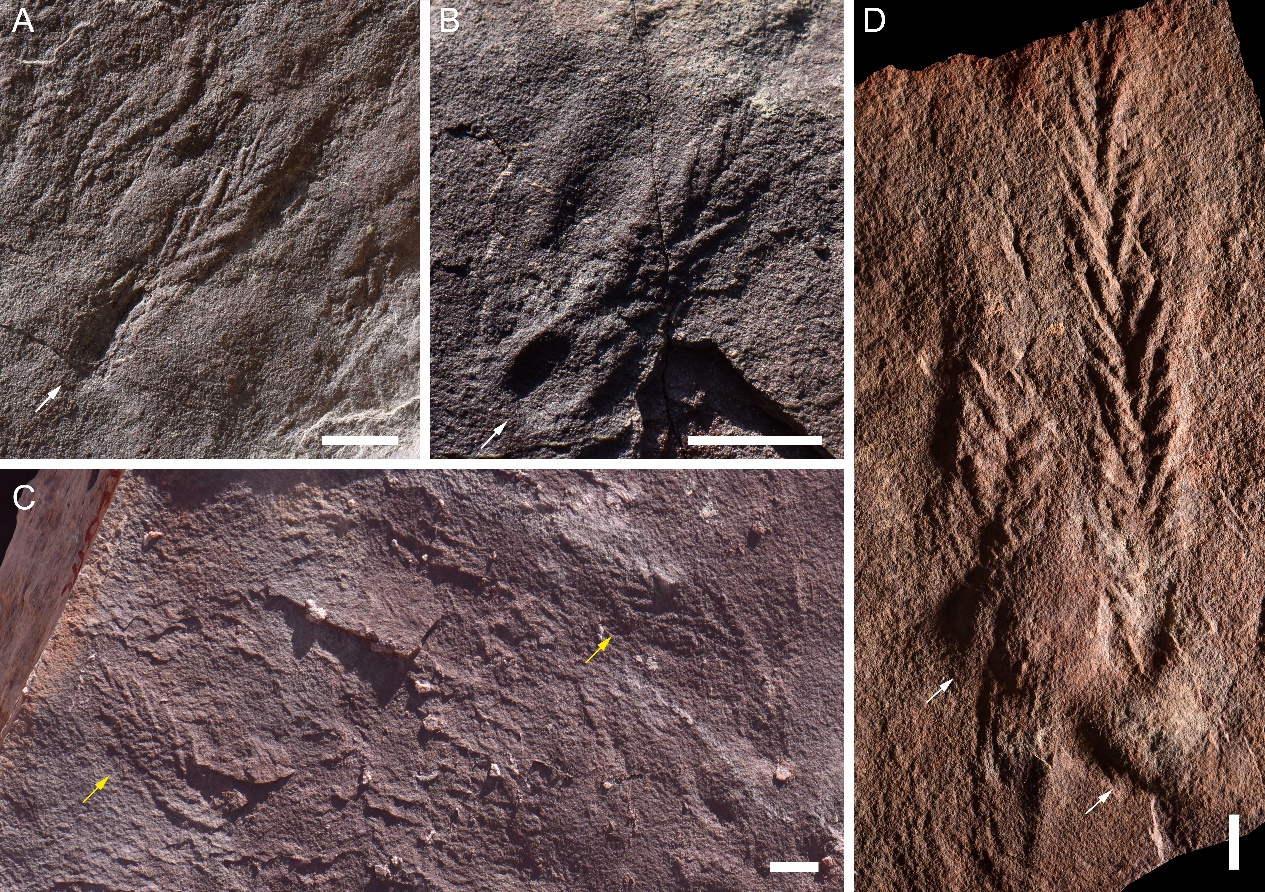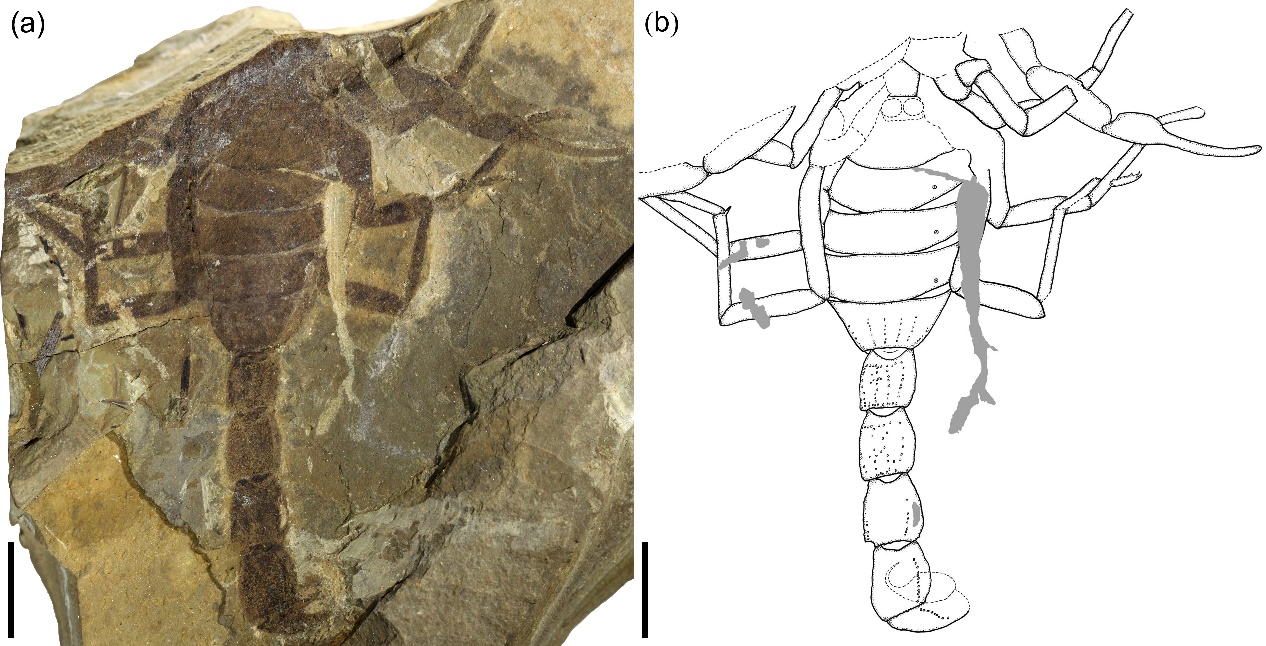科研进展
-
阿盖特珊瑚分类研究取得新进展
阿盖特珊瑚(Agetolitid corals)是一类繁盛于晚奥陶世的床板珊瑚,其化石记录在全球范围内广泛分布,具有重要的地层、古地理和古气候意义。然而,阿盖特珊瑚经过科研人员近百年来的研究,所积累的大量数据较为零散且缺乏系统修订,限制了对该类珊瑚演化历史的深入理解。近年来,中国科学院南京地质古生物研究所研究员王光旭与博士研究生崔雨浓系统总结了这类珊瑚的分类和演化,成果于近期正式发表在Australasian Palaeontological Memoirs。科研人员通过对保存在国内及澳大利亚科研单位模式材料进行重新研究,对大量分类单元进行系统学修订,结合已发表的信息,修订阿盖特珊瑚的分类方案。与此同时,科研人员结合化石新数据及最新地层对比框架,汇总其地质记录和演化历史,认为阿盖特珊瑚起源于凯迪期早期(距今约4.52亿年)的华北,自凯迪晚期(距今约4.49亿年)占据当时几乎所有低纬度地区,但在凯迪末期(距今约4.45亿年)因受奥陶纪末大灭绝事件影响而绝迹。本研究成果受到国家重点研发计划项目、国家自然科学基金及古生物学与油气地层应用全国重点实验室的支持。论文相关信息:Wang, G.X., Cui, Y.N. 2025. Systematics and evolution of agetolitid tabulate corals. Australasian Palaeontological Memoirs 57, 273–361.晚奥陶世凯迪期阿盖特珊瑚古地理分布022025-04 -
科学家发现迄今为止最古老的层孔海绵化石层孔海绵是奥陶纪-泥盆纪(古生代)标志性的浅海造礁动物之一,在礁构建中的作用、生态地位和地理分布上类似于现代珊瑚。在中奥陶世达瑞威尔晚期(距今4.6亿年前),层孔海绵几乎同时融入热带至亚热带气候区的全球礁生态系统。因为受到奥陶纪生物大辐射事件(Great Ordovician Biodiversification Event, GOBE)期间海洋生物多样化的影响,这一时期的着礁生态系统从微生物主导向层孔海绵和珊瑚主导转变。然而,层孔海绵突然融入礁生态系统引发一系列有趣的关键科学问题:最早的层孔海绵何时出现?它们是如何获得矿化骨骼的?最早的层孔海绵在古生态中扮演了什么角色?它们如何成为礁生态系统的重要组成部分?层孔海绵如何在全球范围内几乎同时分布并对礁生态系统做出贡献?因为缺少早期层孔海绵的化石记录而无从得知。近日,中国科学院南京地质古生物研究所早古生代研究团队与韩国古生物研究团队等专家在宜昌远安发现了迄今为止最古老的层孔海绵化石(距今4.8亿年前),名为嫘(léi)祖冠毛层孔海绵(Lophiostroma leizunia sp. nov. Jeon)。这一发现不仅将造礁的层孔海绵的化石记录提前了约2000万年,还揭示了早期礁生态系统和生物矿化演化的独特机制。该成果于北京时间4月1日在《美国国家科学院院刊》(PNAS)上发表,为这些问题提供新的见解。通过研究,嫘祖冠毛层孔海绵是通过氟磷灰石(fluorapatite)构建其骨骼的,这在整个海绵类中从未见过(以往研究表明海绵化石骨骼建造要么是碳酸钙,要么是硅)。这一新发现确立了多孔动物门(Porifera),这是第一个已知的利用三种主要生物矿物质(硅、碳酸钙和磷酸钙)的后生动物门。早期层孔海绵骨骼中磷酸盐的存在拓展了人类对早期动物生物矿化能力的理解,这表明早期海绵可能已具备多样化生物矿化策略所需的遗传能力。不仅如此,嫘祖冠毛层孔海绵还形成复杂的礁结构,在框架构建和结合其他造礁生物组分(如钙微生物、石松海绵、瓶筐石、棘皮动物等)方面发挥了关键作用。这些早期的层孔海绵所建造的礁结构的复杂性堪比后来的礁生态系统。这一发现将造礁层孔海绵的化石记录提前了约2000万年。这项研究的意义不仅在于填补了层孔海绵早期演化历史的空白,还为理解早期动物的生物矿化过程提供了新的视角。它揭示了地球历史上关键时期礁生态系统的复杂性,以及生物如何适应和改变环境。研究团队认为,嫘祖冠毛层孔海绵可能代表了磷酸盐生物矿化的早期"实验品",后来在海洋化学变化的背景下被基于碳酸盐的海绵所取代。这一发现强调了环境因素在塑造生物演化过程中的重要性。总而言之,这项研究不仅推进了我们对早期生命演化的理解,还为未来研究早期地球环境与生物相互作用提供了新的方向。它展示了生物多样性和生态系统复杂性在地球历史早期阶段(距今4.8亿年前)就已经存在,为我们理解现代海洋生态系统的起源和演化提供了宝贵的线索。该成果受到国家自然科学基金等项目的支持。论文相关信息:Juwan Jeon, Mar Simonet Roda, Zhong-Yang Chen, Cui Luo, Stephen Kershaw, Daeyeong Kim, Jun-Ye Ma, Jeong-Hyun Lee, Yuan-Dong Zhang, 2025. Phosphatic stromatoporoid sponges formed reefs ~480 Mya. Proceedings of the National Academy of Sciences, Vol. 122, No. 0, e2426105122, https://doi.org/10.1073/pnas.2426105122图1 嫘祖冠毛层孔海绵(Lophiostroma leizunia sp. nov. Jeon)构造,纵切面(A-D, F, G)和横切面(E, H-I)特征图2 嫘祖冠毛层孔海绵的元素分布图3 宜昌远安发现的早奥陶世层孔海绵-棘皮动物生物礁<!--!doctype-->012025-04
-
硅质岩中微体化石为寒武纪生命大爆发增添新证据寒武纪大爆发是地球生命史上最重要的演化事件之一。在埃迪卡拉纪-寒武纪界线上下,曾经繁盛的埃迪卡拉型宏体复杂生物消失,迅速崛起的后生动物在约1800万年内(539–521 Ma)首次塑造出以生物扰动底质为主、由复杂食物网构成的显生宙型生态系统。此前,对这一关键生命演化事件的认识,主要依赖于浅水碳酸盐岩和磷酸盐质岩石中较为连续的小壳动物化石记录,以及主要保存在碎屑岩中的埃迪卡拉型宏体化石与遗迹化石。由于全球各地浅水环境下的埃迪卡拉纪-寒武纪界线附近地层普遍存在沉积间断,这一转折时期的生物演化过程记录并不完整。近期,中国科学院南京地质古生物研究所研究员朱茂炎团队提出,埃迪卡拉纪-寒武纪界线附近的硅质岩沉积可作为揭示这一时期生物变革的新窗口。该研究成果以副研究员罗翠为论文的第一作者,于3月10日在线发表于著名学术期刊《地质学》(Geology)杂志。自太古宙以来,硅质岩一直是能够精美地保存非矿化生物及其解剖学细节的特异化石埋藏窗口。从上世纪九十年代至今,中国学者不乏对华南寒武纪和埃迪卡拉纪硅质岩中化石的研究,曾识别出数十个微体藻类化石形态属。研究团队在这些工作的基础上,通过对华南8条埃迪卡拉系-寒武系界线剖面的硅质岩开展微体化石和碳同位素地层学等研究,揭示出两个特征不同的化石组合。在埃迪卡拉纪末期(550–539 Ma)硅质岩中,化石组合面貌以亲缘关系未定的串珠状和带状化石为主,其中Horodyskia和Nenoxites尤为常见。这些化石主要以粘土矿物铸型保存,不同于其他硅质岩埋藏窗口中常见的以碳质或完全矿化(permineralization)方式保存的化石。在寒武纪早期(539–521 Ma)硅质岩中,化石组合以多样性高且保留了精细的解剖细节为特征,包括疑源类化石、藻类微体化石、动物矿化骨骼化石(如海绵骨针和小壳化石),以及一系列亲缘关系尚不明确的碳质化石。其中一枚来自路溪勺剖面的大型带刺疑源类标本与埃迪卡拉纪早期的类似化石遥相呼应,表明部分古老的生物类群可能从埃迪卡拉纪延续至寒武纪。硅质岩中的海绵骨针化石记录可追溯到寒武系底部碳同位素负异常(BACE)的极低值点之下,表明海绵动物的生物矿化能力与阿纳巴管等小壳动物化石一样,都起源于寒武纪之前。值得关注的是,寒武纪化石组合中出现了一些形态复杂的碳质膜状化石。这类化石的形态特征与藻类显著不同,在寒武纪之前的硅质岩中未见报道,可能与动物的角质表皮有关,显示了寒武纪初期真核多细胞生物在软组织结构上的创新。从硅质岩化石组合中得到的认识与前人依据其他化石埋藏窗口所获得的认识基本一致,即埃迪卡拉纪-寒武纪界线附近,生物圈面貌发生了迅速转变,少数埃迪卡拉纪分子延续到寒武纪,同时寒武纪特有的动物骨骼化石可下延至BACE极值之下。这种一致性既巩固了前人的结论,也表明硅质岩中的化石记录有潜力成为揭示埃迪卡拉纪-寒武纪之交生物变革的新窗口。埃迪卡拉纪-寒武纪硅质岩在不同水深环境都有分布,且能记录非矿化生物组织的精细结构,可与浅水相地层中保存的动物骨骼化石所提供的信息形成互补。因而,这方面的研究值得今后特别关注和期待。研究还表明,两个化石组合的代表性分子在整个扬子板块普遍存在,从西到东(云南到安徽)、从近岸台地环境到远岸上斜坡环境都有发现。但两个组合在纵向上很少有交集。此前,仅有一篇报道提及两个化石组合在同一层位出现。今后的研究还需进一步关注两个化石组合之间的差异是否受到埋藏偏差或者或沉积间断的影响,以期为埃迪卡拉纪-寒武纪界线的地层学及演化事件研究提供更丰富的证据。该研究得到了国家重点研发计划和国家自然科学基金的资助,团队众多成员参与了野外研究,Soo-Yeun Ahn 在博士后研究期间为论文研究材料的积累做出重要贡献。论文相关信息:Luo, C.*, and Zhu, M.*, 2025, Chert Lagerstätten as a new window to the biological revolution across the Ediacaran–Cambrian boundary: Geology, doi:10.1130/G52956.1.图1 研究剖面及其在纽芬兰世时的岩相古地理分布图2 埃迪卡拉纪末期化石组合(A–F)与寒武纪早期化石组合(G–O)的直观对比。图3 寒武纪硅质岩中的部分碳质膜状化石图4 (A)埃迪卡拉纪-寒武纪之交硅质岩特异埋藏窗口与其他埋藏窗口的年代分布及各窗口中的代表性化石。(B)埃迪卡拉纪-寒武纪之交硅质岩中化石分子的空间分布。282025-03
-
黎巴嫩北部发现目前全球唯一的侏罗纪琥珀昆虫琥珀作为大自然的“时光胶囊”,为研究地球历史和生命演化提供了独特的窗口。它不仅保存了古生物的形态,还记录了远古时期的环境信息,成为古生物学研究的重要媒介。此前已知最早的含有生物内含物的琥珀来自意大利三叠纪地层,而其余所有含有生物内含物的琥珀均来自白垩纪或更晚的地层。侏罗纪琥珀一直是研究的空白。近日,中国科学院南京地质古生物研究所研究员丹尼·阿扎领导的研究团队,在黎巴嫩北部安图林(Aintourine)晚侏罗世(基默里奇阶)琥珀中发现了一枚珍贵的侏罗纪昆虫化石。该化石被命名为Jankotejacoccus libanogloria,是迄今为止已知最早的侏罗纪琥珀昆虫内含物,揭示了介壳虫雄性特征在进化早期阶段就已出现。该成果于近期发表于《国家科学评论》(National Science Review)。此次发现的Jankotejacoccus libanogloria是一种植食性成年雄性介壳虫,与其他介壳虫显著不同,因此被归入一个新科。该化石揭示了介壳虫雄性特征在进化早期阶段就已出现,包括形态和行为上的转变。晚侏罗世的原始介壳虫雄性化石在形态上与现生类群相关,并与当时占主导地位的裸子植物共生。这枚琥珀化石被证明来源于掌鳞杉科(Cheirolepidiaceae)裸子植物。沉积物与琥珀边界呈半角状的形态表明,这种树脂的低黏度可能是导致生物在此类琥珀中保存稀少的主要原因之一。此外,科研人员重建了当时的古环境,即:被森林覆盖的临时沼泽栖息地,生长着高大的南洋杉、银杏类树木以及灌木蕨类、树蕨和水生蕨类。琥珀通体透明,内含真菌孢子、矿物和有机残骸(炭、树叶、木材和真菌)。没有迹象表明琥珀经历了长距离运输或再沉积,因此,科研人员推测,琥珀的沉积环境可能位于产琥珀树木附近。这一发现为琥珀森林生态系统的起源提供了新的见解。未来对黎巴嫩琥珀沉积物的发现与研究有望增强人们对现代生态系统早期发展的理解,也将为中生代中期的生物多样性和陆地生态演化提供更多借鉴。文章信息:Peter Vršanský*, Hemen Sendi, Júlia Kotulová, Jacek Szwedo, Martina Havelcová, Helena Palková, Lucia Vršanská, Jakub Sakala, L'ubica Puškelová, Marián Golej, Adrian Biroň, Daniel Peyrot, Donald Quicke, Didier Néraudeau, Pavel Uher, Sibelle Maksoud, Dany Azar*, 2025. Jurassic Park approached: a coccid from Kimmeridgian cheirolepidiacean Aintourine Lebanese amber. National Science Review, Volume 12: nwae200, https://doi.org/10.1093/nsr/nwae200黎巴嫩北部安图林侏罗纪琥珀生态重建 (Júlia Káčerová供图).恐龙视野中的安图林侏罗纪琥珀森林和化石证据 (Júlia Káčerová供图).黎巴嫩侏罗纪琥珀中的雄性蚧壳虫Jankotejacoccus libanogloria182025-03
-
中国新疆发现二叠纪末大灭绝期间的陆地“避难所”
距今约2.52亿年的二叠纪末大灭绝是寒武纪以来最严重的一次生物危机,大量研究表明这次危机导致了当时海洋中80%以上的物种灭绝。然而,这次灭绝对陆地的影响至今仍存在诸多争论。古生物学界的观点明显分两派。一派学者认为,二叠纪末大灭绝期间,西伯利亚大火成岩省的喷发,给陆地生态系统带来野火、酸雨、有毒气体和紫外线辐射增加等环境灾难。另一派学者则认为导致大灭绝期间陆地环境灾难的因素在全球的分布受到不同纬度大气环流的制约,难以引起像海洋一样的全球性环境灾难。除此之外还有一部分学者则提出折中假说:认为在大灭绝期间,内陆地区可能存在一些避难所,保护了陆地植被免受二叠纪末大灭绝期间的环境灾难的影响,保存了陆地植被的多样性,使植被能在此连续演化,并在灭绝事件的环境灾难消退后快速复苏和辐射。自2019年开始,中国科学院南京地质古生物研究所博士彭辉平在研究员刘锋的指导下,与中国科学院南京地质古生物研究所研究员万明礼、美国密苏里科技大学教授杨晚以及中国科学院古脊椎动物与古人类研究所研究员刘俊合作,对我国新疆吐哈盆地西缘出露的南桃东沟剖面中产出的孢粉化石进行了详细研究,发现二叠纪末大灭绝期间的陆地“避难所”,成果于北京时间3月13日发表于《科学进展》(Science Advances)。科研人员通过与利用该剖面上发现的多层火山灰高精度CA-ID-TIMS铀-铅同位素年龄建立的贝叶斯年龄模型的对比,发现桃东沟地区从二叠纪末大灭绝前16万年一直到大灭绝结束后的16万年,当地一直存在繁盛的临水蕨原和松柏类森林,即:这些森林在南桃东沟地区的延续并未被二叠纪末大灭绝打断。科研人员根据部分与孢粉化石同层原位保存的、具有复杂根系结构的松柏类树干化石和蕨类茎秆化石的研究表明,南桃东沟剖面发现的大量孢粉化石不是再沉积的产物,而是当地植被产生的。经过对南桃东沟二叠纪末大灭绝前后地层中保存的孢粉化石属种多样性统计,科研人员在已发现的33个孢粉属中并未发现大灭绝导致任何一个孢粉属灭绝。在南桃东沟二叠—三叠纪之交地层中发现的约99种孢粉化石约有55%的孢粉属种在灭绝后消失,这暗示可能存在植物群灭绝,但当科研人员与全球和临近剖面的孢粉数据对比后发现,这55%消失的孢粉属种是由于区域环境波动,导致这些孢粉母体植物暂时迁出南桃东沟地区,因为这些消失的孢粉属种在世界其他地区甚至在临近的新疆其他同时代剖面的早三叠世地层中都大量存在。若将世界其他地区的孢粉数据纳入考虑,南桃东沟剖面记录的孢粉化石种在大灭绝后真正灭绝的可能仅为21%,远低于海洋生物在同期的灭绝率。这一系列证据表明,新疆吐哈盆地南桃东沟地区在二叠纪大灭绝期间并未出现明显的陆地植被大灭绝现象。科研人员在南桃东沟剖面发现与孢粉和植物化石同层保存的大量四足动物骨骼化石表明,在二叠纪末大灭绝结束后仅75,000年,该地区已开始出现大量食草四足动物水龙兽和食肉动物迟滞鳄。这些动物的出现表明当地已形成包括初级生产者、初级消费者和次级消费者在内的复杂陆地生态系统。这表示逃过二叠纪大灭绝的植被对整个南桃东沟地区的陆地生态系统重建极为重要。根据之前主流观点认为,二叠纪末大灭绝导致陆地初级生产力大幅降低后,陆地生态系统的多样性需要超过100万年才能恢复到灭绝前的水平。但是,从南桃东沟剖面产出的化石表明,当地陆地生态多样性恢复的速度却比其他地区快10倍以上,这也反证了新疆吐哈盆地南桃东沟地区在二叠纪大灭绝期间并未出现明显的陆地植被大灭绝现象。由于这些四足动物在新疆地区较早地层中没有相关化石记录,科研人员认为,它们是二叠纪末大灭绝后从其他地区迁移而来。这说明,南桃东沟在二叠纪末大灭绝后相对其他地区具有更丰茂的水草和宜居的环境,为这些迁入动物的生存提供了必要条件,使它们能在大灭绝后的短短几万年内快速大量繁衍。科研人员通过与中桃东沟地层剖面古土壤基质的减钾风化指数对比发现,当地植被能够逃过二叠纪末大灭绝期间的环境灾难,主要与当地长期稳定的局地气候有关。根据中桃东沟剖面古土壤基质的减钾风化指数显示,该地区在二叠纪灭绝前后一直保持半湿润—季节性干旱气候,常年降雨维持在1000毫米左右。这种气候即使在二叠纪末大灭绝期间也保持稳定,是导致南桃东沟地区植被在二叠纪大灭绝中得以保存的主要原因。最新研究显示,人类现在可能正处于地球第六次生物大灭绝中,在这次灭绝事件中,找到陆地生物的天然避难所对人类至关重要。新疆南桃东沟的化石证据表明,尽管新疆吐哈盆地在二叠纪末大灭绝期间与西伯利亚大火成岩省这一导致二叠纪末生物大灭绝的主要诱因距离很近,然而,看似最危险的地方却出现了陆地植被的避难所,成为陆地其他生物快速复苏的“生态绿洲”。这一发现启示我们:导致生物灭绝的环境因素在陆地的分布确实受到不同纬度大气环流和局地气候的限制,表面上最危险的地方反而可能最为安全。本系列研究受到国家自然科学基金、国家重点研发计划、第二次青藏高原综合科学考察研究和美国国家科学基金的联合资助。文章信息:Peng, H.P., Yang, W., Wan, M.L., Liu, J., Liu, F.*, 2025, Refugium amidst ruins: Unearthing the lost flora that escaped the end-Permian mass extinction. Science Advances. DOI: https://doi.org/10.1126/sciadv.ads5614在炎热的吐哈盆地南桃东沟剖面采集样品。在新疆南桃东沟剖面二叠纪末大灭绝开始时期的地层中发现的裸子植物或种子蕨类的双气囊花粉。在新疆南桃东沟剖面保存的四足动物骨骼化石,其出现年代约为二叠纪末大灭绝前15万年。在南桃东沟剖面发现的松柏类树干化石,其出现年代为二叠纪末大灭绝开始时期。左图显示的是在新疆桃东沟剖面发现的木贼类化石,其出现年代约为二叠纪末大灭绝后5万年。这些植物被认为是水龙兽(Lystrosaurs)——大灭绝后最常见的陆生四足动物的主要食物来源。木贼的大量存在为桃东沟地区在二叠纪末大灭绝后不久形成的多样化陆地生态系统提供了充足的食物。值得注意的是,这些古代木贼与如今常见于水边环境中的现代木贼类(右图)几乎完全相同。在南桃东沟剖面采集岩石样本时,我们意外地在二叠纪—三叠纪界线附近发现了一枚四足动物骨骼化石。新疆南桃东沟地区二叠纪末大灭绝前(B)、二叠纪末大灭绝期间(A)和二叠纪末大灭绝后(C)陆地景观复原图。(杨定华绘制)发现二叠至三叠纪之交陆地“生命绿洲”的南桃东沟剖面;黄点指示产出早三叠世铀-铅同位素年龄的火山灰层位;红星代表发掘出下图早三叠世完整的四足动物骨骼化石的层位。132025-03 -
青藏高原东北缘首次发现侏罗纪冈瓦纳型植物木化石柴达木盆地位于青藏高原东北缘,是研究中生代陆地生态系统演化和能源资源勘探开发的关键地区。自上世纪50年代以来,该地区早—中侏罗世植物及孢粉化石研究取得了系列研究成果。然而作为古植物研究的重要载体,木化石在柴达木盆地陆相侏罗系鲜有记录。近期,由中国科学院南京地质古生物研究所研究员王永栋、德国森肯堡研究院博士谢奥伟以及沈阳师范大学古生物学院教授田宁等科研人员组成的中德联合研究团队,在柴达木盆地东北缘距今约1.86亿年的早侏罗世地层中,发现了一种保存完好的木化石新材料,并开展了系统解剖学研究,确认其分类学属性并揭示其对古生物地理和古气候研究的重要意义。研究成果发表于英国剑桥大学出版的国际学术期刊《地质学杂志》(Geological Magazine )。科研人员发现该化石具有如下木材解剖特征,即南洋杉式管胞径壁纹孔、多元交叉场纹孔类型(罗汉松型、杉木型纹孔及卵孔)及管胞腔内密集发育横隔膜等。这些形态特征支持将其归入已灭绝的松柏类植物——变异罗汉松型木属(Metapodocarpoxylon Dupéron-Laudoueneix et Pons)。变异罗汉松型木属之前的化石记录主要出现在中侏罗世到白垩纪时期。本次发现自柴达木盆地的新标本材料,将其化石记录提前到早侏罗世(提前了2000万年左右时间)。该木化石生长年轮清晰,具有早材发育、晚材较窄,早晚材之间为急变的特征。结合古植物、孢粉与沉积学数据,表明在早侏罗世时期,柴达木盆地气候温暖湿润,树木生长及降水条件适宜并具有季节性变化,为茂密针叶树森林生长提供了合适的条件,与现今的植被气候条件完全不同。该结论与古植物孢粉学研究提出的侏罗纪早期“松柏类主导的温带湿润气候”论断一致,为东亚内陆地区侏罗纪植被重建与古气候模型构建补充了关键证据。值得关注的是,变异罗汉松型木属化石在中生代的分布具有显著的区域特征。迄今已发现的40余处全球化石产地仅出现在冈瓦纳北部地区。空间格局上,自中东的黎巴嫩延伸至南美的秘鲁,形成了一条明显的纬度带。此次报道的标本是该属在劳亚大陆的首次发现,将其古生物地理分布范围从冈瓦纳北部地区延伸到了劳亚大陆,甚至更偏北的地区。综上,本次研究揭示出变异罗汉松型木属可能自早侏罗世起源于劳亚大陆,后受到气候变化的影响向冈瓦纳地区迁移。该项研究突破了传统地理分布的认知,改写了变异罗汉松型木属的古植物地理分布历史,有助于深入了解地质历史时期植物的迁移和演化规律。本项研究得到中国国家自然科学基金、中国科学院B类战略先导项目及古生物学和地层学国家重点实验室基金项目联合资助。论文信息:Xie, A.*, Chen, H., Wang, Y.*, Tian, N.*, Xu, M., Zhu, Y., Zhang, L., Teng, X., Uhl, D. 2024. An exceptionally preserved conifer wood Metapodocarpoxylon from the Jurassic of northeastern Qinghai-Xizang (Tibetan) Plateau, and its palaeobiogeographic and palaeoclimatic significances. Geological Magazine, 162(e7): 1–10. https://doi.org/10.1017/S0016756824000451图1. 发现自柴达木盆地下侏罗统的变异罗汉松型木属(Metapodocarpoxylon)木化石解剖构造,示横切面(a-c)和径切面(d-h)特征图2. 发现自柴达木盆地下侏罗统的变异罗汉松型木属(Metapodocarpoxylon)木化石解剖构造,示径切面(a-d)和旋切面(e-i)特征图3. 变异罗汉松型木属(Metapodocarpoxylon)木化石的全球化石记录与古地理分布模式<!--!doctype-->102025-03
-
西藏南部白垩纪中期钙质超微化石研究新进展
钙质超微化石(calcareous nannofossils)最早出现于晚三叠世,并在侏罗纪早期成为海洋生物圈中的重要组成部分,随后在侏罗纪期间经历了显著辐射。进入白垩纪后,钙质超微浮游生物成为海洋生态系统中最为重要且广泛分布的生物群体之一,被视为中生代海洋中的最重要的“革新”之一。钙质超微化石在白垩纪海相地层中极为丰富,凭借其个体微小、演化迅速、分布广泛的特点,在生物地层学和古海洋学研究中发挥了不可替代的作用。近日,中国科学院南京地质古生物研究所博士研究生韩美玲、研究员李罡、德国波鸿鲁尔大学教授Jörg Mutterlose、德国莱布尼兹汉诺威大学教授Ulrich Heimhofer组成的国际科研团队,对西藏南部岗巴地区强东剖面开展了系统的白垩纪中期钙质超微化石生物地层学的研究,研究成果发表在国际学术期刊《白垩纪研究》(Cretaceous Research)上。此研究在强东剖面Albian阶至Turonian阶共识别出七个生物事件(钙质超微化石生物带UC0–UC7)。研究剖面下部Eiffellithus turriseiffelii的首现面指示Albian晚期的时代特征。生物地层标志种Corollithion kennedyi(UC1a底部,100.5Ma)和Quadrum intermedium(UC5c底部,94.1Ma)的首现面分别界定了Albian/Cenomanian和Cenomanian/Turonian的界线。除此之外,Watznaueria barnesiae的主导地位表明化石群落的多样性和丰度明显受到成岩作用的驱动。该研究为藏南岗巴地区提供了详细的Albian晚期至Turonian早期钙质超微化石生物地层框架,并通过与定日地区钙质超微化石数据的对比,进一步提高了藏南地区白垩系生物地层的划分精度。此外,中等到较差的钙质超微化石保存状况表明定日和岗巴地区均受到成岩作用的影响。根据相关属种的古生态意义计算得到的温度和营养指标与先前研究结果存在一定偏差,进一步突显了钙质超微化石保存状态在进行区域生物地层对比和讨论古生态意义时的重要性。韩美玲为论文第一作者,李罡担任通讯作者。本研究得到了国家自然科学基金的资助。论文信息:Han, M., Li, G.*, Heimhofer, U., Mutterlose, J., 2025. Late Albian–early Turonian calcareous nannofossils from southern Tibet—implications for preservation, biostratigraphy and palaeoecology.Cretaceous Research, 171:106101. https://doi.org/10.1016/j.cretres.2025.106101图1 研究区区域构造简图及剖面位置图2 强东剖面的岩性、CaCO3含量、钙质超微化石主要分类群的相对丰度以及温度(TI)、营养指标(NI)。042025-03 -
泰国西部早古生代牙形类研究取得系列进展
泰国西部与中国云南保山地区在早古生代同属滇缅马地体,位于冈瓦纳大陆周缘的低纬度区域。2019年11月,中国科学院南京地质古生物研究所与泰国玛哈沙拉堪大学签署合作备忘录,开启了双方在地质古生物领域的深度合作。在该备忘录的支持下,南京古生物所早古生代研究团队分别于2020年1月和2023年3月前往泰国,与泰国玛哈沙拉堪大学教授Clive Burrett、副教授Mongkol Udchachon和Hathaithip Thassanapak联合开展野外考察,并采集了大量奥陶纪与志留纪的牙形类样品。近期,南京古生物所早古生代研究团队副研究员陈中阳、方翔,助理研究员李文杰等与泰国科研人员合作,对采集的样品进行深入分析与系列研究,取得了重要成果,丰富了泰国西部早古生代牙形类的化石记录,为理解该地区早古生代古生物群落特征及古地理环境提供新视角,成果已于近日发表在《古地理学报(英文版)》(Journal of Palaeogeography)和《远古世界》(Palaeoworld)。(1)泰国西部班塔克拉登(Ban Tha Kradan)地区奥陶纪牙形类研究取得新进展研究团队在泰国西部班塔克拉登地区首次报道了9属11种牙形类化石。通过对岩性特征和地层时代的综合分析,研究团队将班塔克拉登地区的塔马瑙组(Tha Manao Formation)上段厘定为帕卡埃组(Pa Kae Formation)。结合牙形类及其他宏体化石的研究,团队指出,塔马瑙组的时代为早奥陶世弗洛晚期至中奥陶世达瑞威尔期,而帕卡埃组的时代为晚奥陶世桑比期至凯迪早期。这一成果为泰国西部奥陶纪地层的划分与对比提供了重要依据。(2)泰国西部志留纪早期牙形类动物群首次被报道本研究首次在泰国西部志留纪早期地层中发现牙形类化石。研究团队在克罗恩卡瓦亚森林公园(Kroeng Kravia Forest Park)地区采集并分析了牙形类样品,识别出志留系兰多维列统特列奇阶上部的Pterospathodus amorphognathoides amorphognathoides下亚带。沉积微相和牙形类组合的研究表明,这些牙形类化石产自较深水的海相环境。此外,该地区的牙形类动物群与我国云南保山、陕西岚皋,以及澳大利亚、劳伦、环冈瓦纳地区的深水相牙形类动物群具有高度相似性,这表明这些地区之间的牙形类动物群可能通过洋流进行交流。本系列研究受到国家重点研发计划、第二次青藏高原综合科学考察研究、中国科学院战略性先导科技专项(B类)、国家自然科学基金、地质调查项目,以及泰国玛哈沙拉堪大学的联合资助。详细论文信息:Chen, Z.Y., Li, W.J., Fang, X., Li, C., Burrett, C., Udchachon, M., Zhang, Y.D., 2024. Ordovician conodonts from the Ban Tha Kradan area, western Thailand. Palaeoworld, 33(3), 546-558. https://doi.org/10.1016/j.palwor.2022.12.004Chen, Z.Y., Thassanapak, H., Li, W.J., Wu, X.J., Udchachon, M., Fang, X., Burrett, C., 2025. First documentation of early Silurian conodonts from western Thailand and its geological implications. Journal of Palaeogeography, 14(1): 157-171. https://doi.org/10.1016/j.jop.2024.08.010图1 泰国西部班塔克拉登地区塔马瑙组的奥陶纪牙形类图2 泰国西部克罗恩卡瓦亚森林公园地区的志留纪牙形类图3 下奥陶统弗洛阶至上奥陶统凯迪阶滇缅马地体与华南上扬子区地层对比图4 大洋环流影响了深水相牙形类动物群(Panderodus langkawiensis-Pterospathodus pennatus procerus-Dapsilodus spp.)的分布032025-03 -
全吉山生物群恰尼虫化石研究埃迪卡拉生物群(~5.74-5.39亿年前)记录了寒武纪大爆发之前复杂生物的演化过程,多种证据表明其中一些类型属于后生动物。为了弄清埃迪卡拉生物群内部的演化过程,前人基于全球化石分布的统计数据,通过定量的方法将埃迪卡拉生物群划分为三个主要组合,即阿瓦隆组合(~5.74-5.60亿年前)、白海组合(~5.60-5.50亿年前)和纳玛组合(~5.50-5.39亿年前)。然而,这些组合的形成在多大程度上受到环境、时间、古纬度或埋藏学因素的控制,仍然存在争议。因此,出现在多种岩性以及不同生物组合中的化石类型尤为重要,对它们进行研究有助于我们检验并进一步解释埃迪卡拉生物群的时空分布。近日,来自中国科学院南京地质古生物研究所早期生命研究团队的博士生吴承羲、助理研究员李光金、研究员庞科等人对来自埃迪卡拉纪全吉山生物群的叶状体化石——恰尼虫(Charnia)进行系统研究,为埃迪卡拉生物群中叶状体这一重要类型提供了古生态以及埋藏学方面的新见解。相关研究成果近日发表在国际地学领域专业期刊《古地理,古气候,古生态》(Palaeogeography, Palaeoclimatology, Palaeoecology)上。全吉山生物群位于青藏高原北部柴达木盆地全吉山地区的埃迪卡拉纪皱节山组地层,是近年来该研究团队在第二次青藏科考中发现的。该生物群中含有恰尼虫(Charnia)和陕西迹(Shaanxilithes),这两种生物在全球其他埃迪卡拉生物群中极少共存。恰尼虫通常被认为是阿瓦隆组合的代表,而陕西迹仅存在于埃迪卡拉纪末期(晚于5.5亿年),可能与纳玛组合同期。因此,全吉山生物群可能代表了一个“过渡”型产地。经科研人员研究得知,全吉山生物群的恰尼虫以小型个体为主,整体处于早期发育阶段,并且兼具部分处于更为幼年期的标本。研究通过薄片观察发现,恰尼虫所在层位以泥质粉砂岩和细砂岩为主,其所在的古海洋环境应处于下临滨带(lower shoreface)与过渡带(offshore transition)之间,水动力条件通常较低,可能偶尔有来自风暴事件的高能沉积物输入。全吉山生物群中的恰尼虫可以以三维模铸化石的形式保存,表明其可能在低水动力条件下被沉积物迅速掩埋。这种保存方式较为罕见,表明恰尼虫可能在埋藏前经历过搬运。恰尼虫与陕西迹共存,表明全吉山生物群中的恰尼虫可能是最年轻的记录。恰尼虫跨越了埃迪卡拉纪晚期约3000万年的地质历史,适应了多种环境,显示出极强的环境适应能力。全吉山生物群中恰尼虫的发现,扩展了叶状生物的时空分布;恰尼虫与陕西迹在同一层位出现,表明全吉山生物群中的恰尼虫可能是该化石类型最年轻的记录;其生活环境包括中临滨带(middle shoreface)到深海斜坡等多种类型,则表明这一叶状生物具有非常强的环境适应能力。本研究得到了第二次青藏高原综合科学考察研究、国家自然科学基金委员会、中国科学院青年创新促进会、国家留学基金委、深时数字地球(Deep-time Digital Earth, DDE)国际大科学计划等项目的联合资助。论文信息:Wu, C., Liu, A.G., Liu, Y., Wang, X., Li, G.*, Qu, H., Huang, R., Qiu, M., Zheng, W., Sun, Y., Shi, H., Ouyang, Q., Wan, B., Chen, Z., Zhou, C., Yuan, X., Pang, K.* 2025. The Quanjishan Charnia assemblage from the northern Qaidam Basin, Tibetan Plateau, and implications for palaeoecology and taphonomy of Ediacaran fronds. Palaeogeography, Palaeoclimatology, Palaeoecology, 665: 112816.https://doi.org/10.1016/j.palaeo.2025.112816全吉山生物群中的恰尼虫标本(比例尺均代表1 cm)。全吉山生物群中的幼年期恰尼虫标本(A中比例尺代表5 cm;B–D中比例尺代表1 cm)全吉山生物群中三维保存的恰尼虫(比例尺为1 cm)具固着器的叶状生物二维和三维保存为化石的示意图。282025-02
-
中国首次发现中生代蝎化石——龙城热河蝎热河生物群因发现多种特异埋藏化石而闻名于世,包括带羽毛的恐龙、早期鸟类、多样化的哺乳动物、翼龙、节肢动物、植物化石等,被誉为“20世纪全球最重要的古生物发现之一”。热河生物群的节肢动物主要以昆虫和甲壳类为主。近期,中国科学院南京地质古生物研究所研究员、现代陆地生态系统起源研究团队黄迪颖以及博士生宣强等报道了在热河生物群发现的中生代蝎化石——龙城热河蝎 (Jeholia longchengi gen. et sp. nov.),这也是热河生物群首次报道的蝎化石,新的发现填补了中国中生代蝎化石的空白。该成果发表在Science Bulletin杂志。之所以称之为“龙城热河蝎”,是因该化石来源于热河生物群,种名指示正模标本的存储地属于朝阳市龙城区。在此之前,中国仅报道了三块蝎类化石,包括山东山旺中新世的山东中华蝎Sinoscorpius shandongensis,湖北省泥盆纪的纤跗湖北蝎Hubeiscorpio gracilitarsis,以及内蒙古乌达地区二叠纪的始蝎Eoscorpius sp.。该龙城热河蝎标本基本完整,部分前体缺失,保存于灰黄色泥岩中(图1)。其须肢纤细,足胫节与跗节较长,胸板呈五边形,毒刺尾针较长,根据这些特征可归入杀牛蝎小目Buthida,因缺少毛序及螯肢等特征,科级单元未定。“龙城热河蝎”化石体型较其他国家中生代蝎类化石更大。根据分析,该蝎化石长度可达10厘米,体型相对较大,可能是热河生物群食物网中的次级或三级消费者,或以昆虫、蜘蛛为食,甚至可能捕食小型脊椎动物的幼体,当然,也可能成为一些中大型脊椎动物的食物,如早期鸟类和哺乳动物,以及恐龙等。科研人员通过初步重建热河生物群的食物网发现,龙城热河蝎在生态网络中具有很高的“介数中心性”,表明它可能与当时陆地生态系统的多个物种产生复杂的生态互动(图2)。这一研究为了解热河生物群食物网的复杂性提供了新证据。该标本现保存于辽宁省朝阳市化石谷博物馆,中国科学院南京地质古生物研究所研究员蔡晨阳、中国地质大学(武汉)的黄元耕副研究员参与本项研究,该研究受国家自然科学基金委(41925008,42288201)资助。论文相关信息:Qiang Xuan, Chenyang Cai, Yuangeng Huang, Diying Huang. 2025. First Mesozoic scorpion from China and its ecological implications. Science Bulletin. https://doi.org/10.1016/j.scib.2025.01.035图1 龙城热河蝎Jeholia longchengi gen. et sp. nov. 的正模标本图2 热河生物群古食物网的初步重建(a)与龙城热河蝎的生态复原图(b)(孙捷绘)<!--!doctype-->202025-02

